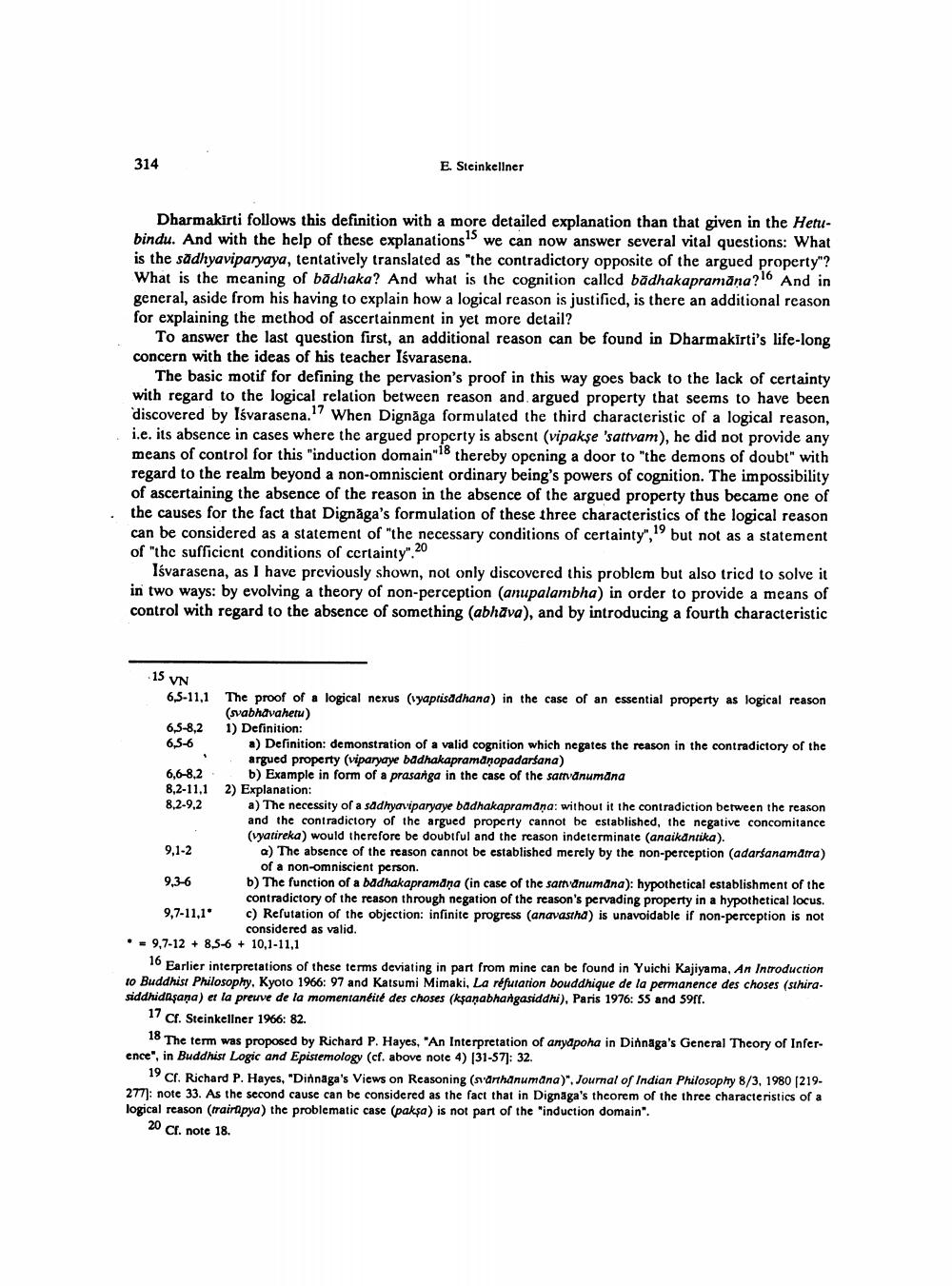Book Title: Logic Of Svabhavahetu In Dhharmakirtis Vadanyaya Author(s): Ernat Steinkellner Publisher: Ernat Steinkellner View full book textPage 4
________________ 314 E. Steinkellner Dharmakirti follows this definition with a more detailed explanation than that given in the Hetubindu. And with the help of these explanations we can now answer several vital questions: What is the sādhyaviparyaya, tentatively translated as "the contradictory opposite of the argued property"? What is the meaning of badhaka? And what is the cognition called badhakapramāna? And in general, aside from his having to explain how a logical reason is justificd, is there an additional reason for explaining the method of ascertainment in yet more detail? To answer the last question first, an additional reason can be found in Dharmakirti's life-long concern with the ideas of his teacher Iśvarasena. The basic motif for defining the pervasion's proof in this way goes back to the lack of certainty with regard to the logical relation between reason and argued property that seems to have been discovered by lśvarasena." When Dignāga formulated the third characteristic of a logical reason, i.e. its absence in cases where the argued property is absent (vipakse 'sattvam), he did not provide any means of control for this "induction domain"18 thereby opening a door to "the demons of doubt" with regard to the realm beyond a non-omniscient ordinary being's powers of cognition. The impossibility of ascertaining the absence of the reason in the absence of the argued property thus became one of the causes for the fact that Dignāga's formulation of these three characteristics of the logical reason can be considered as a statement of the necessary conditions of certainty", but not as a statement of "the sufficient conditions of certainty".20 Isvarasena, as I have previously shown, not only discovered this problem but also tried to solve it in two ways: by evolving a theory of non-perception (anupalambha) in order to provide a means of control with regard to the absence of something (abhava), and by introducing a fourth characteristic 15 VN 6,5-11,1 The proof of a logical nexus (vyaptisadhana) in the case of an essential property as logical reason (svabhavahetu) 6,5-8,2 1) Definition: 6,5-6 a) Definition: demonstration of a valid cognition which negates the reason in the contradictory of the argued property (viparyaye badhakapramanopadarśana) 6,6-8.2 b) Example in form of a prasanga in the case of the sandnumana 8,2-11,1 2) Explanation: 8.2-9,2 a) The necessity of a sadhyaviparyaye badhakapramana: without it the contradiction between the reason and the contradictory of the argued property cannot be established, the negative concomitance (vyatireka) would therefore be doubtful and the reason indeterminate (anaikantika). 9,1-2 a) The absence of the reason cannot be established merely by the non-perception (adarśanamdtra) of a non-omniscient person. 9,3-6 b) The function of a badhakapramdņa (in case of the samdnumana): hypothetical establishment of the contradictory of the reason through negation of the reason's pervading property in a hypothetical locus. 9,7-11,1 c) Refutation of the objection: infinite progress (anavastha) is unavoidable if non-perception is not considered as valid. * = 9,7-12 + 8,5-6 + 10,1-11,1 10 Earlier interpretations of these terms deviating in part from mine can be found in Yuichi Kajiyama, An Introduction to Buddhist Philosophy, Kyoto 1966: 97 and Katsumi Mimaki, La réfutation bouddhique de la permanence des choses (sthira. siddhidasaņa) et la preuve de la momentanéité des choses (ksanabhangasiddhi), Paris 1976: 55 and 59ff. 17 cr. Steinkellner 1966: 82. 18 The term was proposed by Richard P. Hayes, "An Interpretation of anyapoha in Dinnaga's General Theory of Inference", in Buddhist Logic and Epistemology (cf. above note 4) (31-57): 32. 19 cr. Richard P. Hayes, "Dinnaga's Views on Reasoning (svarthanumana)". Journal of Indian Philosophy 8/3, 1980 1219277): note 33. As the second cause can be considered as the fact that in Dignaga's theorem of the three characteristics of a logical reason (trairupya) the problematic case (paksa) is not part of the induction domain". 20 Cf. note 18.Page Navigation
1 2 3 4 5 6 7 8 9 10 11 12 13
